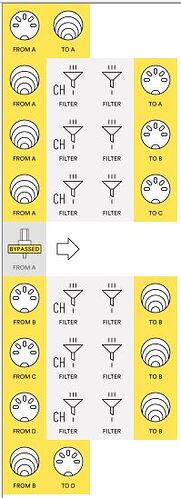Having successfully routed combinations using DIN and USB ports, but not being anything close to a power user, I’m wondering what advantages there are to the virtual ports. I’ve used them as an intermediate step to try them out, but also managed the same results without them. Are they only for fancy, advanced pipelines, or do they have practical uses for more pedestrian routing purposes as well?
One of mine is pedestrian, a 3x1 and 1x3 Merger/Splitter
and my other MIDIHUB is fancy and haunts my mind with the potential.
It is fun to activate and reroute virtual ports with external MIDI controllers, and mapping is easy.
Is it that merging and splitting can only happen via virtual ports, as opposed to point to point directly to the physical ones?
Merging happens automatically if you send multiple ports to the same destination. Virtual ports are useful to have some common parts in the system, like sync information, in a single virtual bus, so you can merge in that information to where it needs to go. Also it could be a bit quicker to change where such information comes from, otherwise, you’d have to edit more input pipes to change your sync master.
Thanks for that explanation. I’ll have to give it some thought to wrap my head around the idea. Is part of it to have pipelines prepared for repeated use that can be just inserted in multiple other pipelines as needed?
Yes, reuse is easier if virtual pipes are used. 
